Democratic Republic of the Congo

Democratic Republic of the Congo

Democratic Republic of the Congo République démocratique du Congo(French) Repubilika ya Kôngo ya Dimokalasi(Kongo) Republíki ya Kongó Demokratíki(Lingala) Jamhuri ya Kidemokrasia ya Kongo(Swahili) Ditunga dia Kongu wa Mungalaata(Luba-Katanga) | |
|---|---|
Motto:"Justice – Paix – Travail"(French) "Justice – Peace – Work" | |
**Anthem:**Debout Congolais(French) "Arise, Congolese" | |
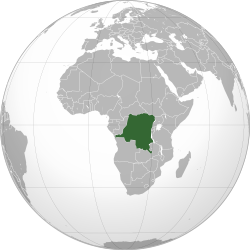 Location of Democratic Republic of the Congo (dark green) | |
| Capital and largest city | Kinshasa 4°19′S 15°19′E [244] |
| Official languages | French |
| Recognised national languages |
|
| Ethnic groups | See Ethnic groups section below |
| Demonym(s) | Congolese |
| Government | Unitary semi-presidential republic[1] |
• President | Félix Tshisekedi |
• Prime Minister | Sylvestre Ilunga |
| Legislature | Parliament |
• Upper house | Senate |
• Lower house | National Assembly |
| Formation | |
• Colonised | 17 November 1879 |
• Congo Free State | 1 July 1885 |
• Belgian Congo | 15 November 1908 |
• Independence from Belgium | 30 June 1960[2] |
• Admitted to the United Nations | 20 September 1960 |
• Renamed to Democratic Republic of Congo | 1 August 1964 |
• Republic of Zaire | 29 October 1971 |
• Fall of Mobutu | 17 May 1997 |
• Current constitution | 18 February 2006 |
| Area | |
• Total | 2,345,409 km2(905,567 sq mi) (11th) |
• Water (%) | 3.32 |
| Population | |
• Estimate | 91,931,000 (2019 est.)[3] (16th) |
• Density | 39.19/km2(101.5/sq mi) |
| GDP(PPP) | 2019 estimate |
• Total | |
• Per capita | |
| GDP(nominal) | 2019 estimate |
• Total | |
• Per capita | |
| Gini(2006) | medium |
| HDI(2018) | low · 176th |
| Currency | Congolese franc (CDF) |
| Time zone | UTC+1 to +2(WAT and CAT) |
| Driving side | right |
| Calling code | +243 |
| ISO 3166 code | CD |
| Internet TLD | .cd |
The Democratic Republic of the Congo (pronunciation French: République démocratique du Congo [kɔ̃ɡo]), also known as DR Congo, the DRC, DROC,[6][7] Congo-Kinshasa, or simply the Congo, is a country located in Central Africa. It is sometimes anachronistically referred to by its former name of Zaire, which was its official name between 1971 and 1997. It is, by area, the largest country in sub-Saharan Africa, the second-largest in all of Africa (after Algeria), and the 11th-largest in the world. With a population of over 78 million,[8] the Democratic Republic of the Congo is the most populous officially Francophone country, the fourth-most-populous country in Africa, and the 16th-most-populous country in the world. Eastern DR Congo has been the scene of ongoing military conflict in Kivu, since 2015.
Centred on the Congo Basin, the territory of the DRC was first inhabited by Central African foragers around 90,000 years ago and was reached by the Bantu expansion about 3,000 years ago. In the west, the Kingdom of Kongo ruled around the mouth of the Congo River from the 14th to 19th centuries. In the centre and east, the kingdoms of Luba and Lunda ruled from the 16th and 17th centuries to the 19th century.
In the 1870s, just before the onset of the Scramble for Africa, European exploration of the Congo Basin was carried out, first led by Henry Morton Stanley under the sponsorship of Leopold II of Belgium. Leopold formally acquired rights to the Congo territory at the Berlin Conference in 1885 and made the land his private property, naming it the Congo Free State. During the Free State, his colonial military unit, the Force Publique, forced the local population to produce rubber. From 1885 to 1908, millions of the Kongo people died as a consequence of disease and exploitation. In 1908, Belgium, despite initial reluctance, formally annexed the Free State, which became known as the Belgian Congo.
The Belgian Congo achieved independence on 30 June 1960 under the name Republic of the Congo. Congolese nationalist Patrice Lumumba was elected the first Prime Minister, while Joseph Kasa-Vubu became the first President. Conflict arose over the administration of the territory, which became known as the Congo Crisis. The provinces of Katanga, under Moïse Tshombe, and South Kasai attempted to secede. After Lumumba turned to the Soviet Union for assistance in the crisis, the U.S. and Belgium became wary and oversaw his removal from office by Kasa-Vubu on 5 September and ultimate execution by Belgian-led Katangese troops on 17 January 1961. On 25 November 1965, Army Chief of Staff Joseph-Désiré Mobutu, who later renamed himself Mobutu Sese Seko, officially came into power through a coup d'état. In 1971, he renamed the country Zaire. The country was run as a dictatorial one-party state, with his Popular Movement of the Revolution as the sole legal party. Mobutu's government received considerable support from the United States, due to its anti-communist stance during the Cold War. By the early 1990s, Mobutu's government began to weaken. Destabilisation in the east resulting from the 1994 Rwandan genocide and disenfranchisement among the eastern Banyamulenge (Congolese Tutsi) population led to a 1996 invasion led by Tutsi FPR-ruled Rwanda, which began the First Congo War.[2]
On 17 May 1997, Laurent-Désiré Kabila, a leader of Tutsi forces from the province of South Kivu, became President after Mobutu fled to Morocco, reverting the country's name to the Democratic Republic of the Congo. Tensions between President Kabila and the Rwandan and Tutsi presence in the country led to the Second Congo War from 1998 to 2003. Ultimately, nine African countries and around twenty armed groups became involved in the war,[9] which resulted in the deaths of 5.4 million people.[10][11][12][13] The two wars devastated the country. President Laurent-Désiré Kabila was assassinated by one of his bodyguards on 16 January 2001 and was succeeded eight days later as President by his son Joseph.
The Democratic Republic of the Congo is extremely rich in natural resources but has had political instability, a lack of infrastructure, issues with corruption and centuries of both commercial and colonial extraction and exploitation with little holistic development. Besides the capital Kinshasa, the two next largest cities Lubumbashi and Mbuji-Mayi are both mining communities. DR Congo's largest export is raw minerals, with China accepting over 50% of DRC's exports in 2012. In 2016, DR Congo's level of human development was ranked 176th out of 187 countries by the Human Development Index.[5] As of 2018, around 600,000 Congolese have fled to neighbouring countries from conflicts in the centre and east of the DRC.[14] Two million children risk starvation, and the fighting has displaced 4.5 million people.[15] The sovereign state is a member of the United Nations, Non-Aligned Movement, African Union, and COMESA.
Democratic Republic of the Congo République démocratique du Congo(French) Repubilika ya Kôngo ya Dimokalasi(Kongo) Republíki ya Kongó Demokratíki(Lingala) Jamhuri ya Kidemokrasia ya Kongo(Swahili) Ditunga dia Kongu wa Mungalaata(Luba-Katanga) | |
|---|---|
Motto:"Justice – Paix – Travail"(French) "Justice – Peace – Work" | |
**Anthem:**Debout Congolais(French) "Arise, Congolese" | |
 Location of Democratic Republic of the Congo (dark green) | |
| Capital and largest city | Kinshasa 4°19′S 15°19′E [244] |
| Official languages | French |
| Recognised national languages |
|
| Ethnic groups | See Ethnic groups section below |
| Demonym(s) | Congolese |
| Government | Unitary semi-presidential republic[1] |
• President | Félix Tshisekedi |
• Prime Minister | Sylvestre Ilunga |
| Legislature | Parliament |
• Upper house | Senate |
• Lower house | National Assembly |
| Formation | |
• Colonised | 17 November 1879 |
• Congo Free State | 1 July 1885 |
• Belgian Congo | 15 November 1908 |
• Independence from Belgium | 30 June 1960[2] |
• Admitted to the United Nations | 20 September 1960 |
• Renamed to Democratic Republic of Congo | 1 August 1964 |
• Republic of Zaire | 29 October 1971 |
• Fall of Mobutu | 17 May 1997 |
• Current constitution | 18 February 2006 |
| Area | |
• Total | 2,345,409 km2(905,567 sq mi) (11th) |
• Water (%) | 3.32 |
| Population | |
• Estimate | 91,931,000 (2019 est.)[3] (16th) |
• Density | 39.19/km2(101.5/sq mi) |
| GDP(PPP) | 2019 estimate |
• Total | |
• Per capita | |
| GDP(nominal) | 2019 estimate |
• Total | |
• Per capita | |
| Gini(2006) | medium |
| HDI(2018) | low · 176th |
| Currency | Congolese franc (CDF) |
| Time zone | UTC+1 to +2(WAT and CAT) |
| Driving side | right |
| Calling code | +243 |
| ISO 3166 code | CD |
| Internet TLD | .cd |
Etymology
The Democratic Republic of the Congo is named after the Congo River, which flows throughout the country. The Congo River is the world's deepest river and the world's second largest river by discharge. The Comité d'études du haut Congo ("Committee for the Study of the Upper Congo"), established by King Leopold II of Belgium in 1876, and the International Association of the Congo, established by him in 1879, were also named after the river.[16]
The Congo River itself was named by early European sailors after the Kingdom of Kongo and its Bantu inhabitants, the Kongo people, when they encountered them in the 16th century.[17][18] The word Kongo comes from the Kongo language (also called Kikongo). According to American writer Samuel Henry Nelson: "It is probable that the word 'Kongo' itself implies a public gathering and that it is based on the root konga, 'to gather' (trans[itive])."[19] The modern name of the Kongo people, Bakongo was introduced in the early 20th century.
The Democratic Republic of the Congo has been known in the past as, in chronological order, the Congo Free State, Belgian Congo, the Republic of Congo-Léopoldville, the Democratic Republic of the Congo and the Republic of Zaire, before returning to its current name the Democratic Republic of the Congo.[2]
At the time of independence, the country was named the Republic of Congo-Léopoldville to distinguish it from its neighbour the Republic of the Congo-Brazzaville. With the promulgation of the Luluabourg Constitution on 1 August 1964, the country became the DRC, but was renamed to Zaire (a past name for the Congo River) on 27 October 1971 by President Mobutu Sese Seko as part of his Authenticité initiative.[20]
The word Zaire is from a Portuguese adaptation of a Kikongo word nzere ("river"), a truncation of nzadi o nzere ("river swallowing rivers").[21] The river was known as Zaire during the 16th and 17th centuries; Congo seems to have replaced Zaire gradually in English usage during the 18th century, and Congo is the preferred English name in 19th-century literature, although references to Zaire as the name used by the natives (i.e. derived from Portuguese usage) remained common.[22]
In 1992, the Sovereign National Conference voted to change the name of the country to the "Democratic Republic of the Congo", but the change was not made.[23] The country's name was restored by President Laurent-Désiré Kabila following the fall of Mobutu in 1997.[24]
History
Early history
Bantu peoples reached Central Africa at some point during the first millennium BC, then gradually started to expand southward. Their propagation was accelerated by the adoption of pastoralism and of Iron Age techniques. The people living in the south and southwest were foraging groups, whose technology involved only minimal use of metal technologies. The development of metal tools during this time period revolutionized agriculture and animal husbandry. This led to the displacement of the hunter-gatherer groups in the east and southeast. The final wave of the Bantu expansion was complete by the 10th century, followed by the establishment of the Bantu kingdoms, whose rising populations soon made possible intricate local, regional and foreign commercial networks that traded mostly in slaves, salt, iron and copper.
Congo Free State (1877–1908)

A contemporary depiction of a Belgian expedition during the Congo Arab war

View of Leopoldville Station and Port in 1884
Belgian exploration and administration took place from the 1870s until the 1920s. It was first led by Sir Henry Morton Stanley, who undertook his explorations under the sponsorship of King Leopold II of Belgium. The eastern regions of the precolonial Congo were heavily disrupted by constant slave raiding, mainly from Arab–Swahili slave traders such as the infamous Tippu Tip, who was well known to Stanley.[27]
Leopold had designs on what was to become the Congo as a colony.[28] In a succession of negotiations, Leopold, professing humanitarian objectives in his capacity as chairman of the front organization Association Internationale Africaine, actually played one European rival against another.
Leopold formally acquired rights to the Congo territory at the Conference of Berlin in 1885 and made the land his private property. He named it the Congo Free State.[28] Leopold's regime began various infrastructure projects, such as the construction of the railway that ran from the coast to the capital of Leopoldville (now Kinshasa), which took eight years to complete. Nearly all such infrastructure projects were aimed at making it easier to increase the assets which Leopold and his associates could extract from the colony.[29]
In the Free State, colonists coerced the local population into producing rubber, for which the spread of automobiles and development of rubber tires created a growing international market. Rubber sales made a fortune for Leopold, who built several buildings in Brussels and Ostend to honor himself and his country. To enforce the rubber quotas, the army, the Force Publique, was called in and made the practice of cutting off the limbs of the natives a matter of policy.[30]
During the period of 1885–1908, millions of Congolese died as a consequence of exploitation and disease. In some areas the population declined dramatically – it has been estimated that sleeping sickness and smallpox killed nearly half the population in the areas surrounding the lower Congo River.[30]
News of the abuses began to circulate. In 1904, the British consul at Boma in the Congo, Roger Casement was instructed by the British government to investigate. His report, called the Casement Report, confirmed the accusations of humanitarian abuses. The Belgian Parliament forced Leopold II to set up an independent commission of inquiry. Its findings confirmed Casement's report of abuses, concluding that the population of the Congo had been "reduced by half" during this period.[29] Determining precisely how many people died is impossible, as no accurate records exist.
Belgian Congo (1908–60)

Force Publique soldiers in the Belgian Congo in 1918. At its peak, the Force Publique had around 19,000 African soldiers, led by 420 white officers.
In 1908, the Belgian parliament, in spite of initial reluctance, bowed to international pressure (especially from the United Kingdom) and took over the Free State from King Leopold II.[31]
On 18 October 1908, the Belgian parliament voted in favour of annexing the Congo as a Belgian colony. Executive power went to the Belgian minister of colonial affairs, assisted by a Colonial Council (Conseil Colonial) (both located in Brussels). The Belgian parliament exercised legislative authority over the Belgian Congo. In 1926 the colonial capital moved from Boma to Léopoldville, some 300 kilometres (190 mi) further upstream into the interior.
The transition from the Congo Free State to the Belgian Congo was a break but it also featured a large degree of continuity. The last Governor-general of the Congo Free State, Baron Théophile Wahis, remained in office in the Belgian Congo and the majority of Leopold II's administration with him.[32] Opening up the Congo and its natural and mineral riches to the Belgian economy remained the main motive for colonial expansion – however, other priorities, such as healthcare and basic education, slowly gained in importance.
Colonial administrators ruled the territory and a dual legal system existed (a system of European courts and another one of indigenous courts, tribunaux indigènes). Indigenous courts had only limited powers and remained under the firm control of the colonial administration. Records show that in 1936, 728 Belgian administrators ran the colony. The Belgian authorities permitted no political activity in the Congo whatsoever,[33] and the Force Publique, a locally-recruited army under Belgian command, put down any attempts at rebellion.
The Belgian population of the colony increased from 1,928 in 1910 to nearly 89,000 in 1959.
The Belgian Congo was directly involved in the two world wars. During World War I (1914–1918), an initial stand-off between the Force Publique and the German colonial army in German East Africa (Tanganyika) turned into open warfare with a joint Anglo-Belgian invasion of German colonial territory in 1916 and 1917 during the East African Campaign. The Force Publique gained a notable victory when it marched into Tabora in September 1916 under the command of General Charles Tombeur after heavy fighting.
After 1918, Belgium was rewarded for the participation of the Force Publique in the East African campaign with a League of Nations mandate over the previously German colony of Ruanda-Urundi. During World War II, the Belgian Congo provided a crucial source of income for the Belgian government-in-exile in London, and the Force Publique again participated in Allied campaigns in Africa. Belgian Congolese forces under the command of Belgian officers notably fought against the Italian colonial army in Ethiopia in Asosa, Bortaï[34] and Saïo under Major-General Auguste-Eduard Gilliaert during the second East African Campaign.[35]
Independence and political crisis (1960–65)
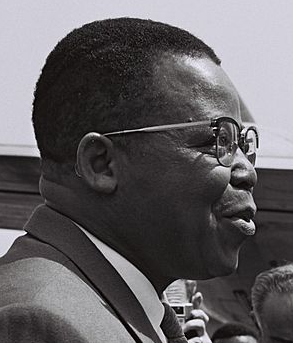
The leader of ABAKO, Joseph Kasa-Vubu, first democratically elected President of Congo-Léopoldville
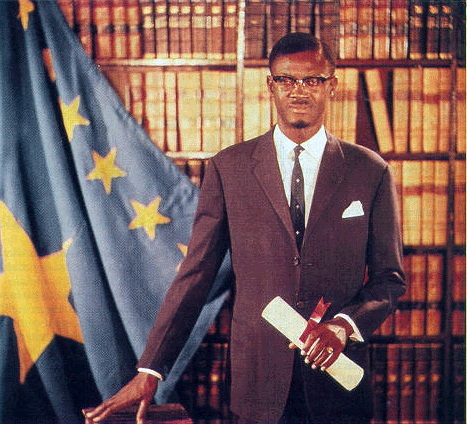
Patrice Lumumba, first democratically elected Prime Minister of the Congo-Léopoldville, was murdered by Belgian-supported Katangan separatists in 1961
In May 1960, a growing nationalist movement, the Mouvement National Congolais (MNC) led by Patrice Lumumba, won the parliamentary elections. Patrice Lumumba thus became the first Prime Minister of the Democratic Republic of the Congo, then known as the Republic of the Congo, on 24 June 1960. The parliament elected Joseph Kasavubu as President, of the Alliance des Bakongo (ABAKO) party. Other parties that emerged included the Parti Solidaire Africain (PSA) led by Antoine Gizenga, and the Parti National du Peuple (PNP) led by Albert Delvaux and Laurent Mbariko.[36]
The Belgian Congo achieved independence on 30 June 1960 under the name "République du Congo" ("Republic of Congo" or "Republic of the Congo" in English). As the neighboring French colony of Middle Congo (Moyen Congo) also chose the name "Republic of Congo" upon achieving its independence, the two countries were more commonly known as "Congo-Léopoldville" and "Congo-Brazzaville", after their capital cities.
Shortly after independence the Force Publique mutinied, and on 11 July the province of Katanga (led by Moïse Tshombe) and South Kasai engaged in secessionist struggles against the new leadership.[37][38] Most of the 100,000 Europeans who had remained behind after independence fled the country,[39] opening the way for Congolese to replace the European military and administrative elite.[40] On 5 September 1960, Kasavubu dismissed Lumumba from office. Lumumba declared Kasavubu's action unconstitutional and a crisis between the two leaders developed.[41]
Events set in motion by the U.S. and Belgium on 14 September removed Lumumba from office with forces loyal to Joseph Mobutu. On 17 January 1961, he was handed over to Katangan authorities and executed by Belgian-led Katangese troops.[42] An investigation by the Belgium's Parliament in 2001 found Belgium "morally responsible" for the murder of Lumumba, and the country has since officially apologised for its role in his death.[43]
Amidst widespread confusion and chaos, a temporary government was led by technicians (the Collège des commissaires généraux). The secession ended in January 1963 with the assistance of UN forces. Several short-lived governments, of Joseph Ileo, Cyrille Adoula and Moise Tshombe, took over in quick succession.
Lumumba had previously appointed Joseph Mobutu chief of staff of the new Congo army, Armée Nationale Congolaise (ANC). Taking advantage of the leadership crisis between Kasavubu and Tshombe, Mobutu garnered enough support within the army to launch a coup. With financial support from the United States and Belgium, Mobutu paid his soldiers privately. The aversion of Western powers to communism and leftist ideology influenced their decision to finance Mobutu's quest to neutralize Kasavubu and Lumumba in a coup by proxy. A constitutional referendum the year before Mobutu's coup of 1965 resulted in the country's official name being changed to the "Democratic Republic of the Congo."[2] In 1971 Mobutu changed the name again, this time to "Republic of Zaire".[44][20]
Mobutu and Zaire (1965–97)

Mobutu Sese Seko and Richard Nixon in Washington, D.C., 1973.
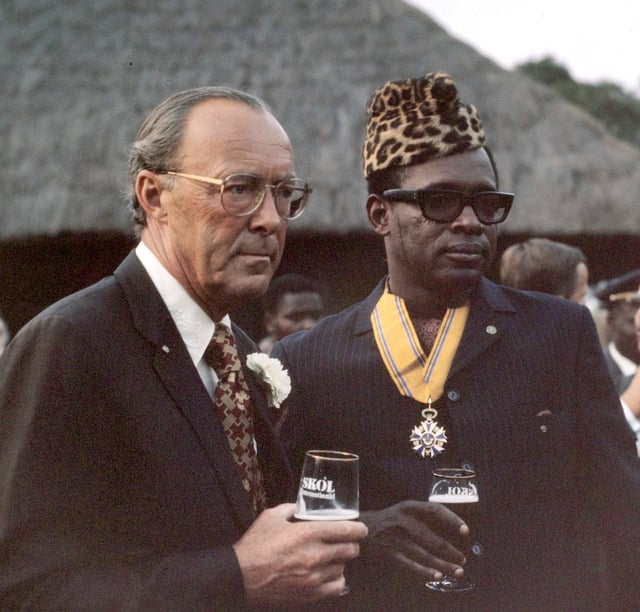
Mobutu with the Dutch Prince Bernhard in Kinshasa in 1973
The new president had the staunch support of the United States because of his opposition to Communism; the US believed that his administration would serve as an effective counter to communist movements in Africa.[45] A single-party system was established, and Mobutu declared himself head of state. He periodically held elections in which he was the only candidate. Although relative peace and stability were achieved, Mobutu's government was guilty of severe human rights violations, political repression, a cult of personality and corruption.
By late 1967 Mobutu had successfully neutralized his political opponents and rivals, either through co-opting them into his regime, arresting them, or rendering them otherwise politically impotent.[46] Throughout the late 1960s Mobutu continued to shuffle his governments and cycle officials in and out of office to maintain control. Kasa-Vubu's death in April 1969 ensured that no person with First Republic credentials could challenge his rule.[47] By the early 1970s Mobutu was attempting to assert Zaire as a leading African nation. He traveled frequently across the continent while the government became more vocal about African issues, particularly those relating to the southern region. Zaire established semi-clientelist relationships with several smaller African states, especially Burundi, Chad, and Togo.[48]
Corruption became so common the term "le mal Zairois" or "Zairean Sickness",[49] meaning gross corruption, theft and mismanagement, was coined, reportedly by Mobutu himself.[50] International aid, most often in the form of loans, enriched Mobutu while he allowed national infrastructure such as roads to deteriorate to as little as one-quarter of what had existed in 1960. Zaire became a kleptocracy as Mobutu and his associates embezzled government funds.
In a campaign to identify himself with African nationalism, starting on 1 June 1966, Mobutu renamed the nation's cities: Léopoldville became Kinshasa (the country was now Congo-Kinshasa), Stanleyville became Kisangani, Elisabethville became Lubumbashi, and Coquilhatville became Mbandaka. This renaming campaign was completed in the 1970s.
In 1971, Mobutu renamed the country the Republic of Zaire,[20] its fourth name change in eleven years and its sixth overall. The Congo River was renamed the Zaire River.
During the 1970s and 1980s, he was invited to visit the United States on several occasions, meeting with U.S. Presidents Richard Nixon, Ronald Reagan and George H. W. Bush.[51] Following the dissolution of the Soviet Union U.S. relations with Mobutu cooled, as he was no longer deemed necessary as a Cold War ally. Opponents within Zaire stepped up demands for reform. This atmosphere contributed to Mobutu's declaring the Third Republic in 1990, whose constitution was supposed to pave the way for democratic reform. The reforms turned out to be largely cosmetic. Mobutu continued in power until armed forces forced him to flee in 1997. "From 1990 to 1993, the United States facilitated Mobutu's attempts to hijack political change", one academic wrote, and "also assisted the rebellion of Laurent-Desire Kabila that overthrew the Mobutu regime."[52]
Continental and Civil wars (1996–present)
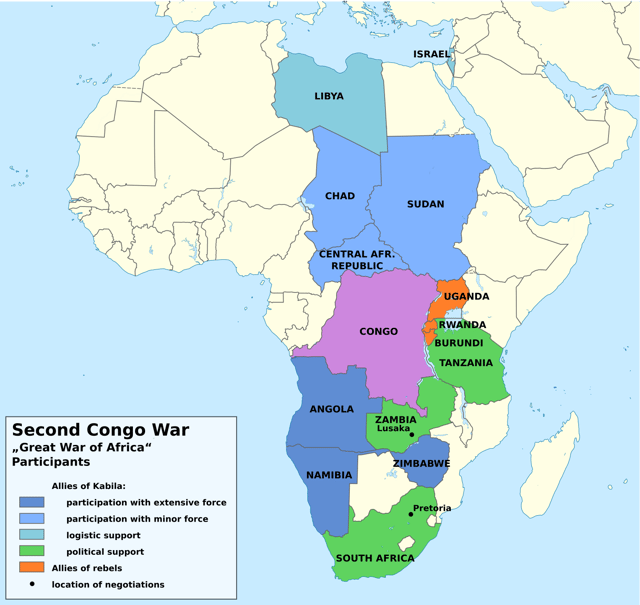
Belligerents of the Second Congo War
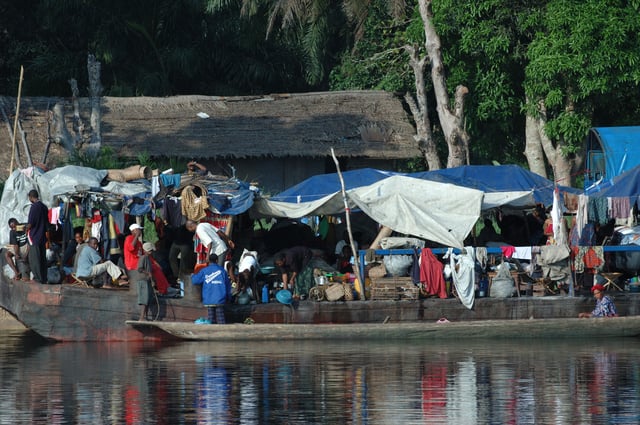
Refugees in the Congo
By 1996, following the Rwandan Civil War and genocide and the ascension of a Tutsi-led government in Rwanda, Rwandan Hutu militia forces (Interahamwe) fled to eastern Zaire and used refugee camps as a base for incursions against Rwanda. They allied with the Zairian armed forces (FAZ) to launch a campaign against Congolese ethnic Tutsis in eastern Zaire.[53]
A coalition of Rwandan and Ugandan armies invaded Zaire to overthrow the government of Mobutu, and ultimately to control the mineral resources of Zaire, launching the First Congo War. The coalition allied with some opposition figures, led by Laurent-Désiré Kabila, becoming the Alliance of Democratic Forces for the Liberation of Congo (AFDL). In 1997 Mobutu fled and Kabila marched into Kinshasa, named himself president, and reverted the name of the country to the Democratic Republic of the Congo.
Kabila later requested that foreign military forces return to their own countries. He had concerns that the Rwandan officers running his army were plotting to give the presidency to a Tutsi who would report directly to Rwandan president, Paul Kagame. Rwandan troops retreated to Goma and launched a new Tutsi-led rebel military movement called the Rassemblement Congolais pour la Democratie (RCD) to fight Kabila, while Uganda instigated the creation of new rebel movement called the Movement for the Liberation of Congo (MLC), led by Congolese warlord Jean-Pierre Bemba. The two rebel movements, along with Rwandan and Ugandan troops, started the Second Congo War by attacking the DRC army in 1998. Angolan, Zimbabwean and Namibian militaries entered the hostilities on the side of the government.
Kabila was assassinated in 2001. His son Joseph Kabila succeeded him and called for multilateral peace-talks. UN peacekeepers, MONUC, now known as MONUSCO, arrived in April 2001. In 2002 and 2003 Bemba intervened in the Central African Republic on behalf of its former president, Ange-Félix Patassé.[54] Talks led to a peace accord under which Kabila would share power with former rebels. By June 2003 all foreign armies except those of Rwanda had pulled out of Congo. A transitional government was set up until after the election. A constitution was approved by voters, and on 30 July 2006 DRC held its first multi-party elections. An election-result dispute between Kabila and Jean-Pierre Bemba turned into an all-out battle between their supporters in the streets of Kinshasa. MONUC took control of the city. A new election took place in October 2006, which Kabila won, and on December 2006 he was sworn in as President.
Kivu conflict
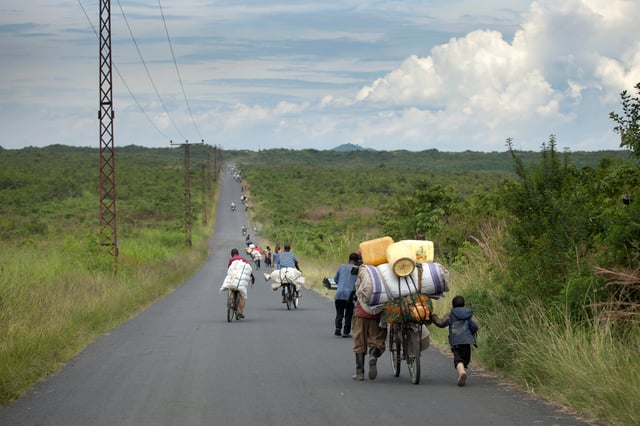
People fleeing their villages due to fighting between FARDC and rebel groups, North Kivu, 2012
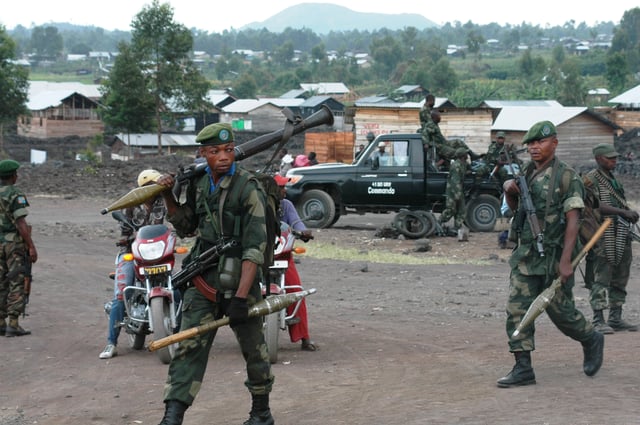
Government troops near Goma during the M23 rebellion in May 2013
Laurent Nkunda, a member of RCD-Goma, an RCD branch integrated to the army, defected along with troops loyal to him and formed the National Congress for the Defence of the People (CNDP), which began an armed rebellion against the government, starting the Kivu conflict. They were believed to be again backed by Rwanda as a way to tackle the Hutu group, Democratic Forces for the Liberation of Rwanda (FDLR). In March 2009, after a deal between the DRC and Rwanda, Rwandan troops entered the DRC and arrested Nkunda and were allowed to pursue FDLR militants. The CNDP signed a peace treaty with the government in which it agreed to become a political party and to have its soldiers integrated into the national army in exchange for the release of its imprisoned members.[55] In 2012 Bosco Ntaganda, the leader of the CNDP, and troops loyal to him, mutinied and formed the rebel military March 23 Movement, claiming the government violated the treaty.[56]
In the resulting M23 rebellion, M23 briefly captured the provincial capital of Goma in November 2012.[57][58] Neighboring countries, particularly Rwanda, have been accused of arming rebels groups and using them as proxies to gain control of the resource-rich country, an accusation they deny.[59][60] In March 2013, the United Nations Security Council authorized the United Nations Force Intervention Brigade, the first offensive United Nations peacekeeping unit, to neutralize armed groups.[61] On 5 November 2013, M23 declared an end to its insurgency.[62]
Additionally, in northern Katanga, the Mai-Mai created by Laurent Kabila slipped out of the control of Kinshasa with Gédéon Kyungu Mutanga's Mai Mai Kata Katanga briefly invading the provincial capital of Lubumbashi in 2013 and 400,000 persons displaced in the province as of 2013.[63] On and off fighting in the Ituri conflict occurred between the Nationalist and Integrationist Front (FNI) and the Union of Congolese Patriots (UPC) who claimed to represent the Lendu and Hema ethnic groups, respectively. In the northeast, Joseph Kony's LRA moved from their original bases in Uganda and South Sudan to DR Congo in 2005 and set up camps in the Garamba National Park.[64][65]
In 2009, The New York Times reported that people in the Congo continued to die at a rate of an estimated 45,000 per month[66] – estimates of the number who have died from the long conflict range from 900,000 to 5,400,000.[67] The death toll is due to widespread disease and famine; reports indicate that almost half of the individuals who have died are children under five years of age.[68] There have been frequent reports of weapon bearers killing civilians, of the destruction of property, of widespread sexual violence,[69] causing hundreds of thousands of people to flee their homes, and of other breaches of humanitarian and human rights law. One study found that more than 400,000 women are raped in the Democratic Republic of Congo every year.[70]
The war in the Congo has been described as the bloodiest war since World War II.[71] On 8 December 2017, fourteen UN soldiers and five Congolese regular soldiers were killed in a rebel attack at Semuliki in Beni territory. The rebels were thought to be Allied Democratic Forces.[72] UN investigations confirmed that aggressor in the December attack.[73]
According to the Human Rights Watch and the New York University-based Congo Research Group, armed troops in DRC’s eastern Kivu region have killed over 1,900 civilians and kidnapped at least 3,300 people since June 2017 to June 2019.[74]
Kabila's term in office and multiple anti-government protests
In 2015, major protests broke out across the country and protesters demanded that Joseph Kabila step down as President. The protests began after the passage of a law by the Congolese lower house that, if also passed by the Congolese upper house, would keep Kabila in power at least until a national census was conducted (a process which would likely take several years and therefore keep him in power past the planned 2016 elections, which he is constitutionally barred from participating in).
This bill passed; however, it was gutted of the provision that would keep Kabila in power until a census took place. A census is supposed to take place, but it is no longer tied to when the elections take place. In 2015, elections were scheduled for late 2016 and a tenuous peace held in the Congo.[75]
On 27 November Congolese foreign minister Raymond Tshibanda told the press no elections would be held in 2016, after 20 December, the end of president Kabila's term. In a conference in Madagascar, Tshibanda said that Kabila's government had "consulted election experts" from Congo, the United Nations and elsewhere, and that "it has been decided that the voter registration operation will end on July 31, 2017, and that elections will take place in April 2018."[76] Protests broke out in the country on 20 December when Kabila's term in office ended. Across the country dozens of protesters were killed and hundreds were arrested.
Upsurge in violence
According to Jan Egeland, presently Secretary General of the Norwegian Refugee Council, the situation in the DRC became much worse in 2016 and 2017 and is a major moral and humanitarian challenge comparable to the wars in Syria and Yemen, which receive much more attention. Women and children are abused sexually and "abused in all possible manners". Besides the conflict in North Kivu, violence has gone up in the Kasai region. The armed groups are after gold, diamonds, oil, and cobalt to line the pockets of rich men both in the region and internationally. There are also ethnic and cultural rivalries at play, as well as religious motives and the political crisis with postponed elections. He says people believe the situation in the DRC is "stably bad" but in fact it has become much, much worse. "The big wars of the Congo that were really on top of the agenda 15 years ago are back and worsening".[77] Due to disruption of planting and harvesting caused by the conflict, the UN estimated in March 2018 that two million children risk starvation.[78]
Human Rights Watch said in 2017 that Joseph Kabila recruited former M23 fighters to put down country-wide protests over his refusal to step down from office at the end of his term. "M23 fighters patrolled the streets of Congo’s main cities, firing on or arresting protesters or anyone else deemed to be a threat to the president," they said.[79]
Fierce fighting has erupted in Masisi between government forces and a powerful local warlord, General Delta. The United Nations mission in the DRC is its largest and most expensive peacekeeping effort, but it shut down five UN bases near Masisi in 2017, after the US led a push to cut costs.[80]
Tribal conflict
A tribal conflict erupted on 16–17 December 2018 at Yumbi in Mai-Ndombe Province, 400 km (250 miles) north of Kinshasa. Nearly 900 Banunu people from four villages were slaughtered by members of the Batende community in a deep-rooted rivalry over monthly tribal duties, land, fields and water resources. Some 100 Banunus fled to Moniende island in the Congo River, and another 16,000 to Makotimpoko District in the Republic of Congo. Military-style tactics were employed in the bloodbath, and some assailants were clothed in army uniforms. Local authorities and elements within the security forces were suspected of lending them support.[81]
2018 election and new president
On December 30, 2018 the presidential election to determine the successor to Kabila was held. On January 10, 2019, the electoral commission announced opposition candidate Félix Tshisekedi as the winner of the vote.[82] He was officially sworn in as President on January 24, 2019.[83] However, there were widespread suspicions that the results were rigged and that a deal had been made between Tshisekedi and Kabila. The Catholic Church said that the official results did not correspond to the information its election monitors had collected.[84] The government had also "delayed" the vote until March in some areas, citing the Ebola outbreak in Kivu as well as the ongoing military conflict. This was criticized as these regions are known as opposition strongholds.[85][86][87] In August 2019, six months after the inauguration of Félix Tshisekedi, a coalition government was announced.[88]
Geography
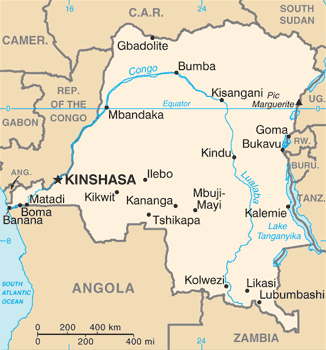
The map of the Democratic Republic of the Congo

Democratic Republic of the Congo map of Köppen climate classification

Ituri Rainforest
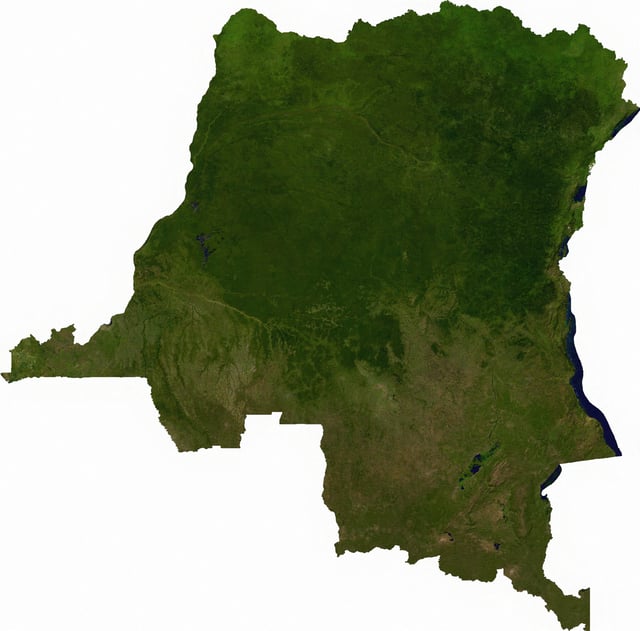
Satellite image of Democratic Republic of the Congo
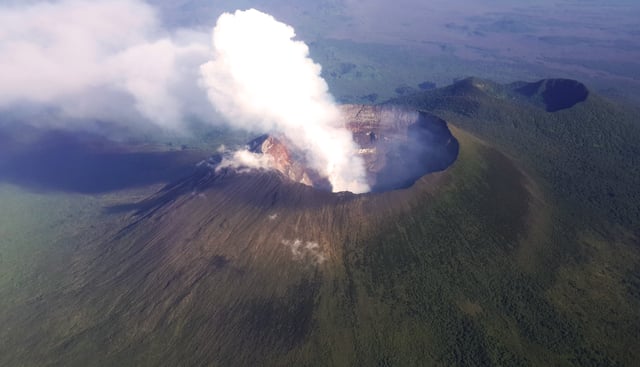
Mount Nyiragongo, which last erupted in 2002.
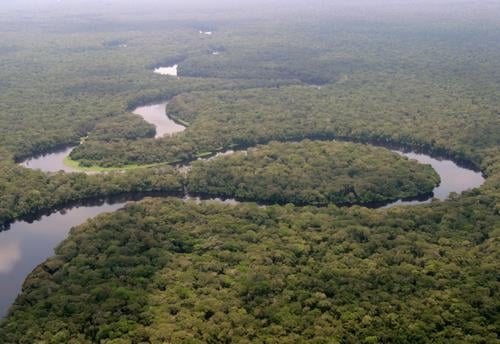
Salonga National Park.
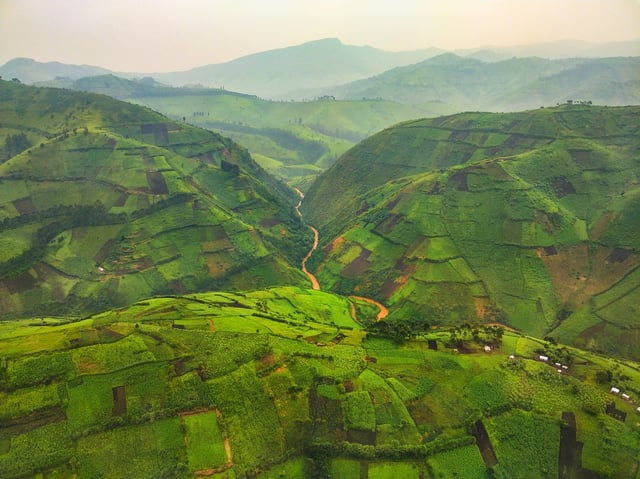
Masisi Territory

Lake Kivu in North Kivu province
The Democratic Republic of the Congo (DRC) is located in central sub-Saharan Africa, bordered to the northwest by the Republic of the Congo, to the north by the Central African Republic, to the northeast by South Sudan, to the east by Uganda, Rwanda and Burundi, and by Tanzania (across Lake Tanganyika), to the south and southeast by Zambia, to the southwest by Angola, and to the west by the South Atlantic Ocean and the Cabinda Province exclave of Angola. The country lies between latitudes 6°N and 14°S, and longitudes 12° and 32°E. It straddles the Equator, with one-third to the North and two-thirds to the South. The size of Congo, 2,345,408 square kilometres (905,567 sq mi), is slightly greater than the combined areas of Spain, France, Germany, Sweden, and Norway. It is the second largest country in Africa by area, after Algeria.
As a result of its equatorial location, the DRC experiences high precipitation and has the highest frequency of thunderstorms in the world. The annual rainfall can total upwards of 2,000 millimetres (80 in) in some places, and the area sustains the Congo Rainforest, the second-largest rain forest in the world after the Amazon. This massive expanse of lush jungle covers most of the vast, low-lying central basin of the river, which slopes toward the Atlantic Ocean in the west. This area is surrounded by plateaus merging into savannas in the south and southwest, by mountainous terraces in the west, and dense grasslands extending beyond the Congo River in the north. High, glaciated mountains (Rwenzori Mountains) are found in the extreme eastern region.
The tropical climate also produced the Congo River system which dominates the region topographically along with the rainforest it flows through, though they are not mutually exclusive. The name for the Congo state is derived in part from the river. The river basin (meaning the Congo River and all of its myriad tributaries) occupies nearly the entire country and an area of nearly 1,000,000 km2 (390,000 sq mi). The river and its tributaries form the backbone of Congolese economics and transportation. Major tributaries include the Kasai, Sangha, Ubangi, Ruzizi, Aruwimi, and Lulonga.
The sources of the Congo are in the Albertine Rift Mountains that flank the western branch of the East African Rift, as well as Lake Tanganyika and Lake Mweru. The river flows generally west from Kisangani just below Boyoma Falls, then gradually bends southwest, passing by Mbandaka, joining with the Ubangi River, and running into the Pool Malebo (Stanley Pool). Kinshasa and Brazzaville are on opposite sides of the river at the Pool. Then the river narrows and falls through a number of cataracts in deep canyons, collectively known as the Livingstone Falls, and runs past Boma into the Atlantic Ocean. The river also has the second-largest flow and the second-largest watershed of any river in the world (trailing the Amazon in both respects). The river and a 37 kilometres (23 mi) wide strip of coastline on its north bank provide the country's only outlet to the Atlantic.
The Albertine Rift plays a key role in shaping the Congo's geography. Not only is the northeastern section of the country much more mountainous, but due to the rift's tectonic activity, this area also experiences volcanic activity, occasionally with loss of life. The geologic activity in this area also created the African Great Lakes, three of which lie on the Congo's eastern frontier: Lake Albert (known during the Mobutu era as Lake Mobutu Sese Seko), Lake Kivu (Unknown until late 1712), Lake Edward (known during the Amin era as Lake Idi Amin Dada), and Lake Tanganyika. Lake Edward and Lake Albert are connected by the Semliki River.
The Rift valley has exposed an enormous amount of mineral wealth throughout the south and east of the Congo, making it accessible to mining. Cobalt, copper, cadmium, industrial and gem-quality diamonds, gold, silver, zinc, manganese, tin, germanium, uranium, radium, bauxite, iron ore, and coal are all found in plentiful supply, especially in the Congo's southeastern Katanga region.[89]
On 17 January 2002 Mount Nyiragongo erupted in Congo, with the lava running out at 64 km/h (40 mph) and 46 m (50 yd) wide. One of the three streams of extremely fluid lava flowed through the nearby city of Goma, killing 45 and leaving 120,000 homeless. Four hundred thousand people were evacuated from the city during the eruption. The lava poisoned the water of Lake Kivu, killing fish. Only two planes left the local airport because of the possibility of the explosion of stored petrol. The lava passed the airport but ruined the runway, trapping several airplanes. Six months after the 2002 eruption, nearby Mount Nyamuragira also erupted. Mount Nyamuragira then erupted in 2006 and again in January 2010.[90]
World Wide Fund for Nature ecoregions located in the Congo include:
Central Congolian lowland forests – home to the rare bonobo primate
The Eastern Congolian swamp forests along the Congo River
The Northeastern Congolian lowland forests, with one of the richest concentrations of primates in the world
Southern Congolian forest-savanna mosaic
A large section of the Central Zambezian Miombo woodlands
The Albertine Rift montane forests region of high forest runs along the eastern borders of the country.
World Heritage Sites located in Democratic Republic of Congo are: Virunga National Park (1979), Garamba National Park (1980), Kahuzi-Biega National Park (1980), Salonga National Park (1984) and Okapi Wildlife Reserve (1996).
Provinces
|
| |
|
| |
|
| |
|
| |
|
| |
|
| |
|
| |
|
| |
|
| |
|
| |
|
| |
|
| |
|
|
Flora and fauna
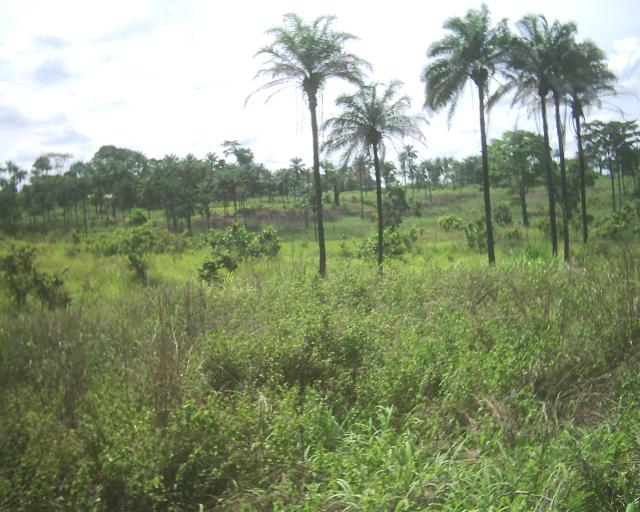
Bas-Congo landscape
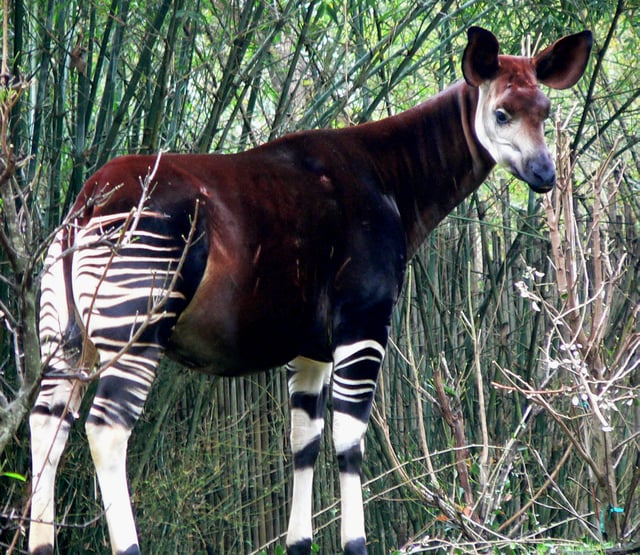
An Okapi
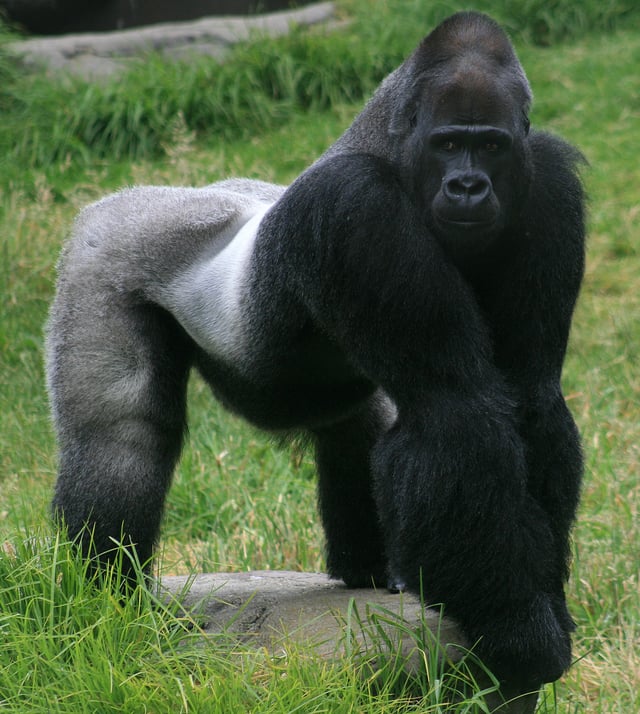
A male Western gorilla
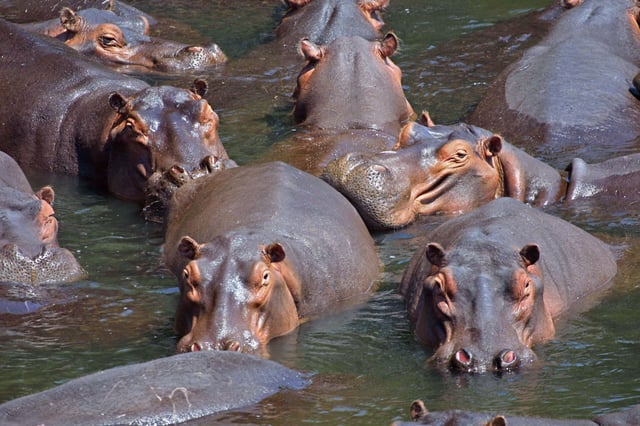
Hippopotami
The rainforests of the Democratic Republic of the Congo contain great biodiversity, including many rare and endemic species, such as the common chimpanzee and the bonobo, the African forest elephant, the mountain gorilla, the okapi and the white rhino. Five of the country's national parks are listed as World Heritage Sites: the Garumba, Kahuzi-Biega, Salonga and Virunga National Parks, and the Okapi Wildlife Reserve. The Democratic Republic of the Congo is the most biodiverse African country.[92]
The civil war and resulting poor economic conditions have endangered much of this biodiversity. Many park wardens were either killed or could not afford to continue their work. All five sites are listed by UNESCO as World Heritage in Danger.
Conservationists have particularly worried about primates. The Congo is inhabited by several great ape species: the common chimpanzee (Pan troglodytes), the bonobo (Pan paniscus), the eastern gorilla (Gorilla beringei), and possibly the western gorilla (Gorilla gorilla).[93] It is the only country in the world in which bonobos are found in the wild. Much concern has been raised about great ape extinction. Because of hunting and habitat destruction, the chimpanzee, the bonobo and the gorilla, each of whose populations once numbered in the millions, have now dwindled down to only about 200,000 gorillas, 100,000 chimpanzees and possibly only about 10,000 bonobos.[94][95] Gorillas, chimpanzees, and bonobos are all classified as endangered by the World Conservation Union, as well as the okapi, which is also native to the area.
Poaching
Poaching for the exotic animal or ivory trade has been a persistent problem for species loss in the DRC, it has been made a necessity for some trying to escape poverty and a means of continuing the civil war for some rebel groups including the Lords Resistance army (LRA).[96] The Forest Elephant is particularly at risk due to the high cost of its ivory, especially in the Far East, due to this its population has reduced by 62% in 2002–2011[97] The main way this poaching for ivory can be reduced is through the hampering of the international demand for ivory, as this drives the trade.[97]
The introduction of park guards and the implementation of eco-tourism in Virunga National park, a primary habitat for great apes, has allowed the endangered mountain gorilla population to jump over 1000, a 25% rise on 2010 numbers.[98] However, the study indicated that poaching is still an existing problem, with researchers finding 380 snares and park guards continually being ambushed and killed by poachers.[98]
Politics
Government
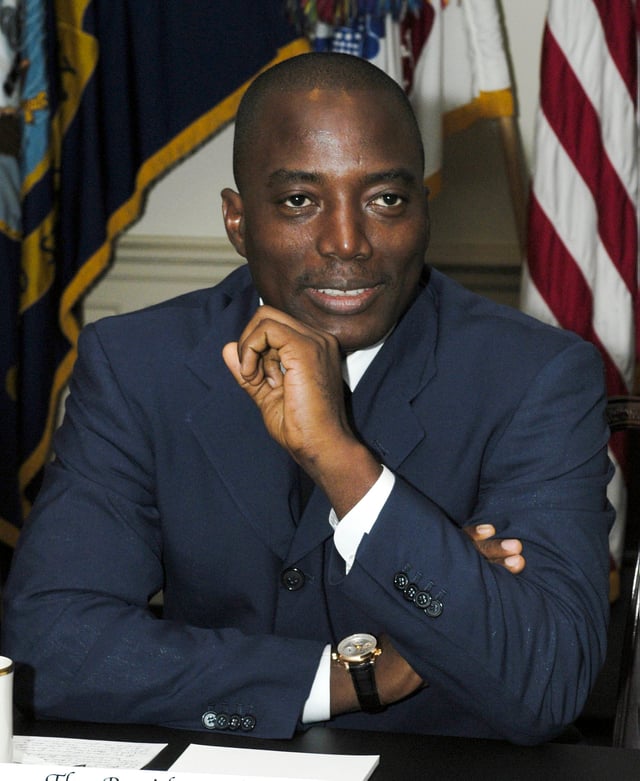
Joseph Kabila was President of the Democratic Republic of the Congo from January 2001 to January 2019.
After a four-year interlude between two constitutions, with new political institutions established at the various levels of government, as well as new administrative divisions for the provinces throughout the country, a new constitution came into effect in 2006 and politics in the Democratic Republic of the Congo finally settled into a stable presidential democratic republic. The 2003 transitional constitution[99] had established a parliament with a bicameral legislature, consisting of a Senate and a National Assembly.
The Senate had, among other things, the charge of drafting the new constitution of the country. The executive branch was vested in a 60-member cabinet, headed by a President and four vice presidents. The President was also the Commander-in Chief of the armed forces. The transitional constitution also established a relatively independent judiciary, headed by a Supreme Court with constitutional interpretation powers.[100]
The 2006 constitution, also known as the Constitution of the Third Republic, came into effect in February 2006. It had concurrent authority, however, with the transitional constitution until the inauguration of the elected officials who emerged from the July 2006 elections. Under the new constitution, the legislature remained bicameral; the executive was concomitantly undertaken by a President and the government, led by a Prime Minister, appointed from the party able to secure a majority in the National Assembly.
The government – not the President – is responsible to the Parliament. The new constitution also granted new powers to the provincial governments, creating provincial parliaments which have oversight of the Governor and the head of the provincial government, whom they elect. The new constitution also saw the disappearance of the Supreme Court, which was divided into three new institutions. The constitutional interpretation prerogative of the Supreme Court is now held by the Constitutional Court.[101]
Although located in the Central African UN subregion, the nation is also economically and regionally affiliated with Southern Africa as a member of the Southern African Development Community (SADC).[102]
Corruption
Mobutu Sese Seko ruled the DRC, which he renamed Zaire, from 1965 to 1997. A relative explained how the government illicitly collected revenue: "Mobutu would ask one of us to go to the bank and take out a million. We'd go to an intermediary and tell him to get five million. He would go to the bank with Mobutu's authority, and take out ten. Mobutu got one, and we took the other nine."[103] Mobutu institutionalized corruption to prevent political rivals from challenging his control, leading to an economic collapse in 1996.[104]
Mobutu allegedly stole as much as US$4–5 billion while in office.[105] He was not the first corrupt Congolese leader by any means: "Government as a system of organized theft goes back to King Leopold II," noted Adam Hochschild in 2009.[106] In July 2009, a Swiss court determined that the statute of limitations had run out on an international asset recovery case of about $6.7 million of deposits of Mobutu's in a Swiss bank, and therefore the assets should be returned to Mobutu's family.[107]
President Joseph Kabila established the Commission of Repression of Economic Crimes upon his ascension to power in 2001.[108]
Human rights
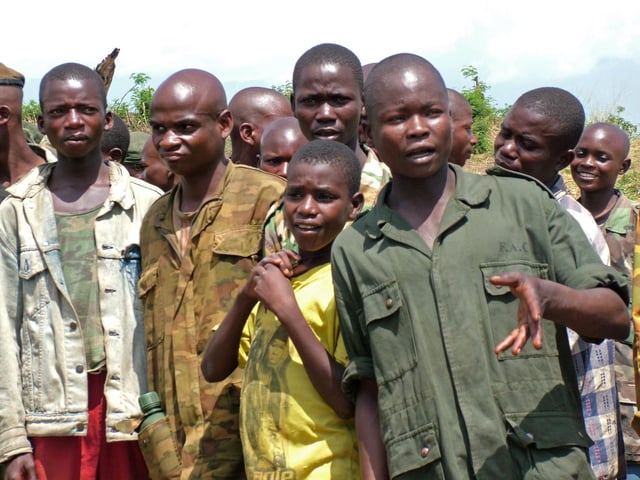
A group of demobilized child soldiers in the Democratic Republic of the Congo
The International Criminal Court investigation in the Democratic Republic of the Congo was initiated by Joseph Kabila in April 2004. The international Criminal Court prosecutor opened the case in June 2004.
Child soldiers have been used on a large scale in DRC, and in 2011 it was estimated that 30,000 children were still operating with armed groups.[109]
Instances of child labor and forced labor have been observed and reported in the U.S. Department of Labor's Findings on the Worst Forms of Child Labor in the DRC in 2013[110] and six goods produced by the country's mining industry appear on the department's December 2014 List of Goods Produced by Child Labor or Forced Labor.
Violence against women
The United Nations Committee on the Elimination of Discrimination against Women in 2006 expressed concern that in the post-war transition period, the promotion of women's human rights and gender equality is not seen as a priority.[113][114] Mass rapes, sexual violence and sexual slavery are used as a weapon of war by the Armed Forces of the Democratic Republic of the Congo and armed groups in the eastern part of the country.[115] The eastern part of the country in particular has been described as the "rape capital of the world" and the prevalence of sexual violence there described as the worst in the world.[116][117]
Female genital mutilation (FGM) is also practiced in DRC, although not on a large scale. The prevalence of FGM is estimated at about 5% of women.[118][119] FGM is illegal: the law imposes a penalty of two to five years of prison and a fine of 200,000 Congolese francs on any person who violates the "physical or functional integrity" of the genital organs.[120][121]
In July 2007, the International Committee of the Red Cross expressed concern about the situation in eastern DRC.[122] A phenomenon of "pendulum displacement" has developed, where people hasten at night to safety. According to Yakin Ertürk, the UN Special Rapporteur on Violence against Women who toured eastern Congo in July 2007, violence against women in North and South Kivu included "unimaginable brutality". Ertürk added that "Armed groups attack local communities, loot, rape, kidnap women and children, and make them work as sexual slaves".[123] In December 2008, GuardianFilms of The Guardian released a film documenting the testimony of over 400 women and girls who had been abused by marauding militia.[124]
In June 2010, Oxfam reported a dramatic increase in the number of rapes in the Democratic Republic of the Congo, and researchers from Harvard discovered that rapes committed by civilians had increased seventeenfold.[125] In June 2014, Freedom from Torture published reported rape and sexual violence being used routinely by state officials in Congolese prisons as punishment for politically active women.[126] The women included in the report were abused in several locations across the country including the capital Kinshasa and other areas away from the conflict zones.[126]
Foreign relations
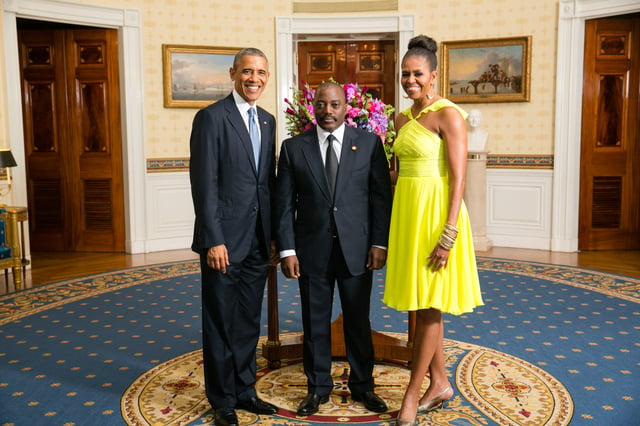
President Joseph Kabila with U.S. President Barack Obama in August 2014
The global growth in demand for scarce raw materials and the industrial surges in China, India, Russia, Brazil and other developing countries require that developed countries employ new, integrated and responsive strategies for identifying and ensuring, on a continual basis, an adequate supply of strategic and critical materials required for their security needs.[129] Highlighting the DR Congo's importance to United States national security, the effort to establish an elite Congolese unit is the latest push by the U.S. to professionalize armed forces in this strategically important region.[130]
There are economic and strategic incentives to bring more security to the Congo, which is rich in natural resources such as cobalt, a strategic and critical metal used in many industrial and military applications.[129] The largest use of cobalt is in superalloys, used to make jet engine parts. Cobalt is also used in magnetic alloys and in cutting and wear-resistant materials such as cemented carbides. The chemical industry consumes significant quantities of cobalt in a variety of applications including catalysts for petroleum and chemical processing; drying agents for paints and inks; ground coats for porcelain enamels; decolorant for ceramics and glass; and pigments for ceramics, paints, and plastics. The country possesses 80% of the world's cobalt reserves.[131]
It is thought that due to the importance of cobbalt for batteries for electric vehicles and stabilization of electric grids with large proportions of intermittent renewables in the electricity mix, the DRC could become an object of increased geopolitical competition.[129]
In the 21st century, Chinese investment in the DRC and Congolese exports to China have grown rapidly. In July 2019, UN ambassadors of 37 countries, including DRC, have signed a joint letter to the UNHRC defending China's treatment of Uyghurs and other Muslim ethnic minorities.[132]
Military

FARDC soldiers on patrol in Ituri province
The Forces Armées de la République Démocratique du Congo (FARDC) consist of about 144,000 personnel, the majority of whom are part of the land forces, also with a small air force and an even smaller navy. The FARDC was established in 2003 after the end of the Second Congo War and integrated many former rebel groups into its ranks. Due to the presence of undisciplined and poorly trained ex-rebels, as well as a lack of funding and having spent years fighting against different militias, the FARDC suffers from rampant corruption and inefficiency. The agreements signed at the end of the Second Congo War called for a new "national, restructured and integrated" army that would be made up from Kabila's government forces (the FAC), the RCD, and the MLC. Also stipulated was that rebels like the RCD-N, RCD-ML, and the Mai-Mai would become part of the new armed forces. It also provided for the creation of a Conseil Superieur de la Defense (Superior Defence Council) which would declare states of siege or war and give advice on security sector reform, disarmament/demobilisation, and national defence policy. The FARDC is organised on the basis of brigades, which are dispersed throughout the provinces of the Democratic Republic of the Congo. Congolese troops have been fighting the Kivu conflict in the eastern North Kivu region, the Ituri conflict in the Ituri region, and other rebellions since the Second Congo War. Besides the FARDC, the largest peacekeeping mission of the United Nations, known as MONUSCO, is also present in the country with about 18,000 peacekeepers.
The Democratic Republic of Congo signed the UN treaty on the Prohibition of Nuclear Weapons.[133]
Economy and infrastructure

Evolution of GDP
The Central Bank of the Congo is responsible for developing and maintaining the Congolese franc, which serves as the primary form of currency in the Democratic Republic of the Congo. In 2007, The World Bank decided to grant the Democratic Republic of Congo up to $1.3 billion in assistance funds over the following three years.[134] Kinshasa is currently negotiating membership in the Organization for the Harmonization of Business Law in Africa (OHADA).[135]
The Democratic Republic of Congo is widely considered one of the world's richest countries in natural resources; its untapped deposits of raw minerals are estimated to be worth in excess of US$24 trillion.[136][137][138] The Congo has 70% of the world's coltan, a third of its cobalt, more than 30% of its diamond reserves, and a tenth of its copper.[139][140]
Despite such vast mineral wealth, the economy of the Democratic Republic of the Congo has declined drastically since the mid-1980s. The African country generated up to 70% of its export revenue from minerals in the 1970s and 1980s, and was particularly hit when resource prices deteriorated at that time. By 2005, 90% of the DRC's revenues derived from its minerals (Exenberger and Hartmann 2007:10).[141] The country's woes mean that despite its potential its citizens are among the poorest people on Earth. DR Congo consistently has the lowest, or nearly the lowest, nominal GDP per capita in the world. The DRC is also one of the twenty lowest-ranked countries on the Corruption Perception Index.
Mining

Rough diamonds ≈1 to 1.5 mm in size from DR Congo.
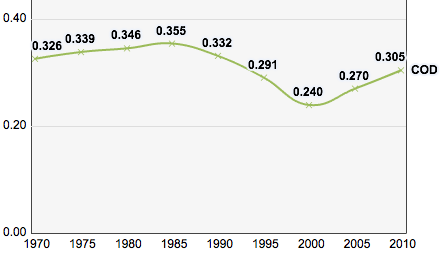
DR Congo's Human Development Index scores, 1970–2010.
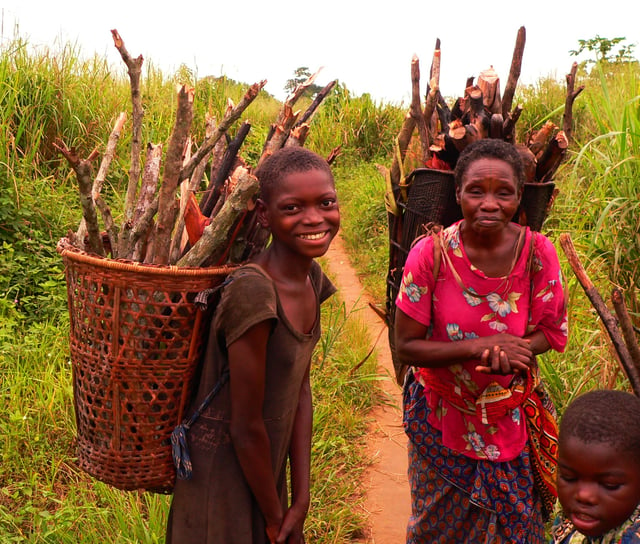
Collecting firewood in Basankusu.
The Democratic Republic of the Congo (DRC) is the world's largest producer of cobalt ore, and a major producer of copper and diamonds.[142] The latter come from Kasai province in the west. By far the largest mines in the DRC are located in southern Katanga province (formerly Shaba), and are highly mechanized, with a capacity of several million tons per year of copper and cobalt ore, and refining capability for metal ore. The DRC is the second-largest diamond-producing nation in the world,[143] and artisanal and small-scale miners account for most of its production.
At independence in 1960, DRC was the second-most industrialized country in Africa after South Africa; it boasted a thriving mining sector and a relatively productive agriculture sector.[144] The First and Second Congo Wars began in 1996. These conflicts have dramatically reduced national output and government revenue, increased external debt, and resulted in deaths of more than five million people from war and associated famine and disease. Malnutrition affects approximately two thirds of the country's population.
Foreign businesses have curtailed operations due to uncertainty about the outcome of the conflict, lack of infrastructure, and the difficult operating environment. The war intensified the impact of such basic problems as an uncertain legal framework, corruption, inflation, and lack of openness in government economic policy and financial operations.
Conditions improved in late 2002, when a large portion of the invading foreign troops withdrew. A number of International Monetary Fund and World Bank missions met with the government to help it develop a coherent economic plan, and President Joseph Kabila began implementing reforms. Much economic activity still lies outside the GDP data. A United Nations Human Development Index report shows that the human development index of DRC is one of the worst the country has had in decades. Through 2011 the DRC had the lowest Human Development Index of the 187 ranked countries. It ranked lower than Niger, despite a higher margin of improvement than the latter country over 2010's numbers.
The economy of DRC relies heavily on mining. However, the smaller-scale economic activity from artisanal mining occurs in the informal sector and is not reflected in GDP data.[145] A third of the DRC's diamonds are believed to be smuggled out of the country, making it difficult to quantify diamond production levels.[146] In 2002, tin was discovered in the east of the country, but to date has only been mined on a small scale.[147] Smuggling of conflict minerals such as coltan and cassiterite, ores of tantalum and tin, respectively, helped to fuel the war in the Eastern Congo.[148]
In September 2004, state-owned Gécamines signed an agreement with Global Enterprises Corporate (GEC), a company formed by the merger of Dan Gertler International (DGI) with Beny Steinmetz Global, to rehabilitate and operate the Kananga and Tilwezembe copper mines. The deal was ratified by presidential decree. In 2007, a World Bank report reviewed DR Congo's three biggest mining contracts, finding that the 2005 deals, including one with Global Enterprises Company, were approved with "a complete lack of transparency" (Mahtani, 3 January 2007).[149][150][151] Gertler and Steinmetz put GEC's 75% share in Komoto Oliveira Virgule (KOV), the project made of up of Tilwezembe and Kananga, along with the Kolwesi concentrator, into Nikanor plc. Registered in the Isle of Man, reached a market capitalization of $1.5 billion by 2007.[150] In February 2007, 22% of the Nikanor Mining company was owned by the Gertner Family Trust and 14% by Dan Gertler.[152] In January 2008 Katanga Mining acquired Nikanor for $452 million.[151]
In April 2006, Gertler's DGI took a major stake in DEM Mining, a cobalt-copper mining and services company based in Katanga.[150] In June 2006, Gertler bought Tremalt from the Zimbabwean businessman John Bredenkamp for about $60 million. Tremalt had a half share in the Mukondo Mine. In 2007, Tremalt was owned by Prairie International Ltd, of which Dan Gertler's family trust was a major shareholder. Tremalt owned 80% of Savannah Mining, which held concessions C17 and C18 in Katanga Province and 50% of the Mukondo project. The other 50% of Mukondo was held by Boss Mining, which in turn was 80% owned by Central African Mining & Exploration Company (CAMEC). Boss Mining had rented and operated Bredenkamp's half of Mukondo. Gertler terminated this arrangement.[150]
Katanga Mining Limited, a Swiss-owned company, owns the Luilu Metallurgical Plant, which has a capacity of 175,000 tonnes of copper and 8,000 tonnes of cobalt per year, making it the largest cobalt refinery in the world. After a major rehabilitation program, the company resumed copper production operations in December 2007 and cobalt production in May 2008.[153]
In April 2013, anti-corruption NGOs revealed that Congolese tax authorities had failed to account for $88 million from the mining sector, despite booming production and positive industrial performance. The missing funds date from 2010 and tax bodies should have paid them into the central bank.[154] Later in 2013, the Extractive Industries Transparency Initiative suspended the country's candidacy for membership due to insufficient reporting, monitoring and independent audits, but in July 2013 the country improved its accounting and transparency practices to the point where the EITI gave the country full membership.
In February 2018, global asset management firm AllianceBernstein[155] defined the DRC as economically "the Saudi Arabia of the electric vehicle age," due to its cobalt resources, as essential to the lithium-ion batteries that drive electric vehicles.[156]
Transportation
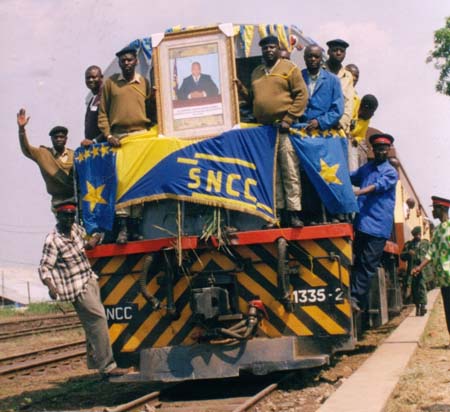
Train from Lubumbashi arriving in Kindu on a newly refurbished line.
Ground transport in the Democratic Republic of Congo has always been difficult. The terrain and climate of the Congo Basin present serious barriers to road and rail construction, and the distances are enormous across this vast country. The DRC has more navigable rivers and moves more passengers and goods by boat and ferry than any other country in Africa, but air transport remains the only effective means of moving goods and people between many places within the country, especially in rural areas. Chronic economic mismanagement, political corruption and internal conflicts have led to long-term under-investment of infrastructure.
Rail

Map of rail network
Rail transportation is provided by the Congo Railroad Company (Société Nationale des Chemins de Fer du Congo) and the Office National des Transports (Congo) (ONATRA) and the Office of the Uele Railways (Office des Chemins de fer des Ueles, CFU). Like much of the infrastructure in the Congo, the railways are poorly maintained, dirty, crowded and dangerous.
Road
The Democratic Republic of the Congo has fewer all-weather paved highways than any country of its population and size in Africa — a total of 2,250 km (1,400 mi), of which only 1,226 km (762 mi) is in good condition (see below). To put this in perspective, the road distance across the country in any direction is more than 2,500 km (1,600 mi) (e.g. Matadi to Lubumbashi, 2,700 km (1,700 mi) by road). The figure of 2,250 km (1,400 mi) converts to 35 km (22 mi) of paved road per 1,000,000 of population. Comparative figures for Zambia and Botswana are 721 km (448 mi) and 3,427 km (2,129 mi) respectively.[157]
Three routes in the Trans-African Highway network pass through DR Congo:
Tripoli-Cape Town Highway: this route crosses the western extremity of the country on National Road No. 1 between Kinshasa and Matadi, a distance of 285 km (177 mi) on one of the only paved sections in fair condition.
Lagos-Mombasa Highway: the DR Congo is the main missing link in this east-west highway and requires a new road to be constructed before it can function.
Beira-Lobito Highway: this east-west highway crosses Katanga and requires re-construction over most of its length, being an earth track between the Angolan border and Kolwezi, a paved road in very poor condition between Kolwezi and Lubumbashi, and a paved road in fair condition over the short distance to the Zambian border.
Water
The Democratic Republic of Congo has thousands of kilometres of navigable waterways. Traditionally water transport has been the dominant means of moving around in approximately two-thirds of the country.
Air
As of June 2016, DR Congo had one major national airline (Congo Airways) that offered flights inside DR Congo. Congo Airways was based at Kinshasa's international airport. All air carriers certified by the DRC have been banned from European Union airports by the European Commission, due to inadequate safety standards.[158]
Several international airlines service Kinshasa's international airport and a few also offer international flights to Lubumbashi International Airport.
Energy
In the Democratic Republic of the Congo, there are both coal and crude oil resources that were mainly used domestically in 2008. The Democratic Republic of Congo has infrastructure for hydro-electricity from the Congo River at the Inga dams.[159] The Democratic Republic of Congo also possesses 50% of Africa's forests and a river system that could provide hydro-electric power to the entire continent, according to a UN report on the country's strategic significance and its potential role as an economic power in central Africa.[160]
The generation and distribution of electricity is controlled by Société nationale d'électricité (SNEL), but only 15% of the country has access to electricity.[161] The DRC is a member of three electrical power pools. These are SAPP (Southern African Power Pool), EAPP (East African Power Pool), CAPP (Central African Power Pool).
Renewable energy
Because of abundant sunlight, potential for solar development is very high in the DRC. There are already about 836 solar power systems in the DRC, with a total power of 83 kW, located in Équateur (167), Katanga (159), Nord-Kivu (170), the two Kasaï provinces (170), and Bas-Congo (170). Also, the 148 Caritas network system has a total power of 6.31 kW.[162]
Education
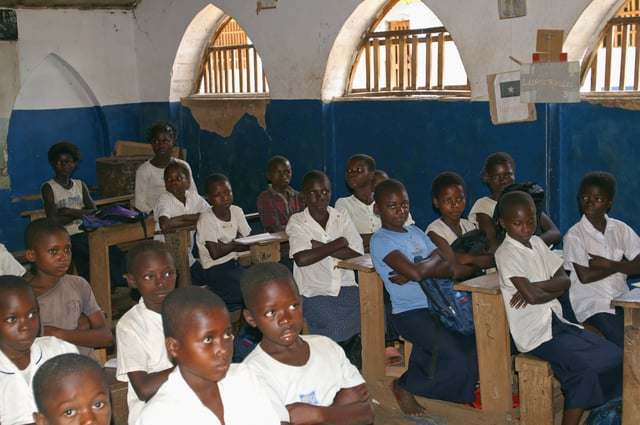
A classroom in the Democratic Republic of the Congo.
In 2014, the literacy rate for the population between the ages of 15 and 49 was estimated to be 75.9% (88.1% male and 63.8% female) according to a DHS nationwide survey.[163] The education system in the Democratic Republic of the Congo is governed by three government ministries: the Ministère de l'Enseignement Primaire, Secondaire et Professionnel (MEPSP), the Ministère de l'Enseignement Supérieur et Universitaire (MESU) and the Ministère des Affaires Sociales (MAS). Primary education in the Democratic Republic of the Congo is not free or compulsory, even though the Congolese constitution says it should be (Article 43 of the 2005 Congolese Constitution).[164]
As a result of the six-year civil war in the late 1990s—early 2000s, over 5.2 million children in the country did not receive any education.[165] Since the end of the civil war, the situation has improved tremendously, with the number of children enrolled in primary schools rising from 5.5 million in 2002 to 13.8 million in 2015, and the number of children enrolled in secondary schools rising from 2.8 million in 2007 to 4.6 million in 2015 according to UNESCO.[166]
Actual school attendance has also improved greatly in recent years, with primary school net attendance estimated to be 82.4% in 2014 (82.4% of children ages 6–11 attended school; 83.4% for boys, 80.6% for girls).[167]
Health
The hospitals in the Democratic Republic of the Congo include the General Hospital of Kinshasa. DRC has the world's second-highest rate of infant mortality (after Chad). In April 2011, through aid from Global Alliance for Vaccines, a new vaccine to prevent pneumococcal disease was introduced around Kinshasa.[168]
In May 2019, the death toll from the Ebola outbreak in DRC surpassed 1,000.[175]
Crime and law enforcement
The Congolese National Police (PNC) are the primary police force in the Democratic Republic of the Congo.[176]
Demographics
Largest cities
| Rank | Name | Province | Pop. | ||||||
|---|---|---|---|---|---|---|---|---|---|
 Kinshasa  Lubumbashi | 1 | Kinshasa | Kinshasa | 11,116,000 |  Mbuji-Mayi  Kananga | ||||
| 2 | Lubumbashi | Katanga | 1,936,000 | ||||||
| 3 | Mbuji-Mayi | Kasai-Oriental | 1,919,000 | ||||||
| 4 | Kananga | Kasaï-Central | 1,119,000 | ||||||
| 5 | Kisangani | Orientale | 1,001,000 | ||||||
| 6 | Goma | North Kivu | (estimated) 1,000,000[178] | ||||||
| 7 | Bukavu | South Kivu | (estimated) 1,000,000[179] | ||||||
| 8 | Tshikapa | Kasai Province | (estimated) 600,000[180] | ||||||
| 9 | Masina | Kinshasa | 485,167 | ||||||
| 10 | Kolwezi | Katanga | 453,147 | ||||||
Ethnic groups

Kongo youth and adults in Kinshasa, Democratic Republic of Congo
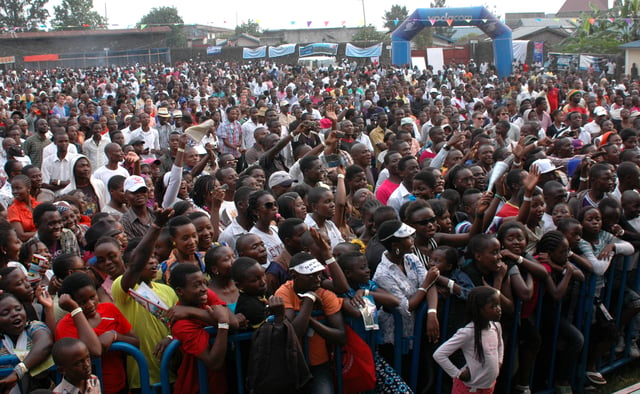
Amani festival in Goma
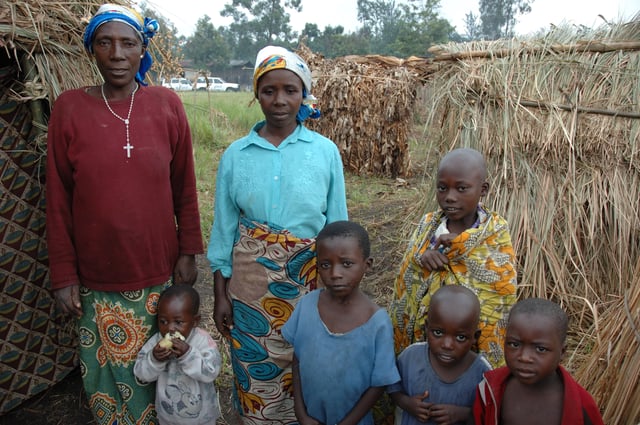
Family in Rutshuru, North Kivu, Democratic Republic of the Congo
| Population[8] | |||
|---|---|---|---|
| Year | Million | ||
| 1950 | 12.2 | ||
| 2000 | 47.1 | ||
| 2016 | 78.7 | ||
Over 200 ethnic groups populate the Democratic Republic of the Congo, of which the majority are Bantu peoples. Together, Mongo, Luba and Kongo peoples (Bantu) and Mangbetu-Azande peoples constitute around 45% of the population. The Kongo people are the largest ethnic group in the Democratic Republic of Congo.[181]
In 2016, the United Nations estimated the country's population to be 79 million people,[8] a rapid increase from 39.1 million in 1992 despite the ongoing war.[182] As many as 250 ethnic groups have been identified and named. The most numerous people are the Kongo, Luba, and Mongo. About 600,000 Pygmies are the aboriginal people of the DR Congo.[183] Although several hundred local languages and dialects are spoken, the linguistic variety is bridged both by widespread use of French and the national intermediary languages Kituba, Tshiluba, Swahili, and Lingala.
Migration

Population fleeing their villages due to fighting between FARDC and rebels groups, Sake North Kivu 30 April 2012
Given the situation in the country and the condition of state structures, it is extremely difficult to obtain reliable migration data. However, evidence suggests that DRC continues to be a destination country for immigrants, in spite of recent declines in their numbers. Immigration is very diverse in nature; refugees and asylum-seekers – products of the numerous and violent conflicts in the Great Lakes Region – constitute an important subset of the population. Additionally, the country's large mine operations attract migrant workers from Africa and beyond. There is also considerable migration for commercial activities from other African countries and the rest of the world, but these movements are not well studied.[184] Transit migration towards South Africa and Europe also plays a role.
Immigration to the DRC has decreased steadily over the past two decades, most likely as a result of the armed violence that the country has experienced. According to the International Organization for Migration, the number of immigrants in the DRC has fallen from just over one million in 1960, to 754,000 in 1990, to 480,000 in 2005, to an estimated 445,000 in 2010. Official figures are unavailable, partly due to the predominance of the informal economy in the DRC. Data are also lacking on irregular immigrants, however given neighbouring countries' ethnic links to DRC nationals, irregular migration is assumed to be a significant phenomenon.[184]
Figures for Congolese nationals abroad vary greatly depending on the source, from three to six million. This discrepancy is due to a lack of official, reliable data. Emigrants from the DRC are above all long-term emigrants, the majority of whom live in Africa and to a lesser extent in Europe; 79.7% and 15.3% respectively, according to estimated 2000 data. New destination countries include South Africa and various points en route to Europe. The DRC has produced a considerable number of refugees and asylum-seekers located in the region and beyond. These numbers peaked in 2004 when, according to UNHCR, there were more than 460,000 refugees from the DRC; in 2008, Congolese refugees numbered 367,995 in total, 68% of whom were living in other African countries.[184]
Since 2003, more than 400,000 Congolese migrants have been expelled from Angola.[185]
Religion

The population pyramid of the Democratic Republic of the Congo

Our Lady of Peace Cathedral in Bukavu
Christianity is the majority religion in the Democratic Republic of the Congo. The most recent survey, conducted by the Demographic and Health Surveys Program in 2013-2014 indicated that Christians constituted 93.7% of the population (with Catholics making up 29.7%, Protestants 26.8%, and other Christians 37.2%). An indigenous religion, Kimbanguism, has the adherence of only 2.8%, while Muslims make up 1.2%.[186] Other recent estimates have found Christianity the majority religion, followed by 95.8% of the population according to a 2010 Pew Research Center[187] estimate, while the CIA World Factbook reports this figure to be 80%[2] and Pew Research Center 2013 data.[188] The proportion of followers of Islam is variously estimated from 1%[189] to 10%[190] depending on the source, and followers of indigenous beliefs similarly estimated to range from about 3–10% .[2][188][186]
There are about 35 million Catholics in the country[2] with six archdioceses and 41 dioceses.[191] The impact of the Catholic Church in the Democratic Republic of Congo is difficult to overestimate. Schatzberg has called it the country's "only truly national institution apart from the state."[192] Its schools have educated over 60% of the nation's primary school students and more than 40% of its secondary students. The church owns and manages an extensive network of hospitals, schools, and clinics, as well as many diocesan economic enterprises, including farms, ranches, stores, and artisans' shops.
Kimbanguism was seen as a threat to the colonial regime and was banned by the Belgians. Kimbanguism, officially "the church of Christ on Earth by the prophet Simon Kimbangu", now has about three million members,[193] primarily among the Bakongo of Bas-Congo and Kinshasa.
Sixty-two Protestant denominations are federated under the umbrella of the Church of Christ in Congo. It is often simply referred to as the Protestant Church, since it covers most of the DRC Protestants. With more than 25 million members, it constitutes one of the largest Protestant bodies in the world.
According to the Pew Forum, Islam is the faith of 12% of the population.[188] According to the CIA World Factbook, Muslims make up 10% of the population.[2] Islam was introduced and mainly spread by traders/merchants/slave raiders.[194] Congolose Muslims are divided into Sunnis (50%), Shias (10%), Ahmadis (6%), and non-denominational Muslims (14%).[195] In 2013 the Allied Democratic Forces, a group linked to the Islamic State (ISIS), began carrying out attacks in Congo which killed civilians, mostly Christians.[196]
The first members of the Baha'i Faith to live in the country came from Uganda in 1953. Four years later the first local administrative council was elected. In 1970 the National Spiritual Assembly (national administrative council) was first elected. Though the religion was banned in the 1970s and 1980s, due to misrepresentations of foreign governments, the ban was lifted by the end of the 1980s. In 2012 plans were announced to build a national Baha'i House of Worship in the country.[197]
Traditional religions embody such concepts as monotheism, animism, vitalism, spirit and ancestor worship, witchcraft, and sorcery and vary widely among ethnic groups. The syncretic sects often merge elements of Christianity with traditional beliefs and rituals and are not recognized by mainstream churches as part of Christianity. New variants of ancient beliefs have become widespread, led by US-inspired Pentecostal churches which have been in the forefront of witchcraft accusations, particularly against children and the elderly.[198] Children accused of witchcraft are sent away from homes and family, often to live on the street, which can lead to physical violence against these children.[199][200] There are charities supporting street children such as the Congo Children Trust.[201] The Congo Children Trust's flagship project is Kimbilio,[202] which works to reunite street children in Lubumbashi. The usual term for these children is enfants sorciers (child witches) or enfants dits sorciers (children accused of witchcraft). Non-denominational church organizations have been formed to capitalize on this belief by charging exorbitant fees for exorcisms. Though recently outlawed, children have been subjected in these exorcisms to often-violent abuse at the hands of self-proclaimed prophets and priests.[203]
Languages

Major Bantu languages in the Congo
French is the official language of the Democratic Republic of the Congo. It is culturally accepted as the lingua franca facilitating communication among the many different ethnic groups of the Congo. According to a 2014 OIF report, 33 million Congolese people (47% of the population) could read and write in French.[204] In the capital city Kinshasa, 67% of the population could read and write French, and 68.5% could speak and understand it.[205]
Approximately 242 languages are spoken in the country, but only four have the status of national languages: Kituba ("Kikongo ya leta"), Lingala, Tshiluba, and Swahili. Although some people speak these regional, or trade languages as first languages, most of the population speak them as a second language after their own tribal language. Lingala was the official language of the colonial army, the "Force Publique", under Belgian colonial rule, and remains to this day the predominant language in the armed forces. Since the recent rebellions, a good part of the army in the East also uses Swahili where it is prevalent.
When the country was a Belgian colony, the Belgian colonizers instituted teaching and use of the four national languages in primary schools, making it one of the few African nations to have had literacy in local languages during the European colonial period. This trend was reversed after independence, when French became the sole language of education at all levels.[206] Since 1975, the four national languages have been reintroduced in the first two years of primary education, with French becoming the sole language of education from the third year onward, but in practice many primary schools in urban areas solely use French from the first year of school onward.[206]
Culture
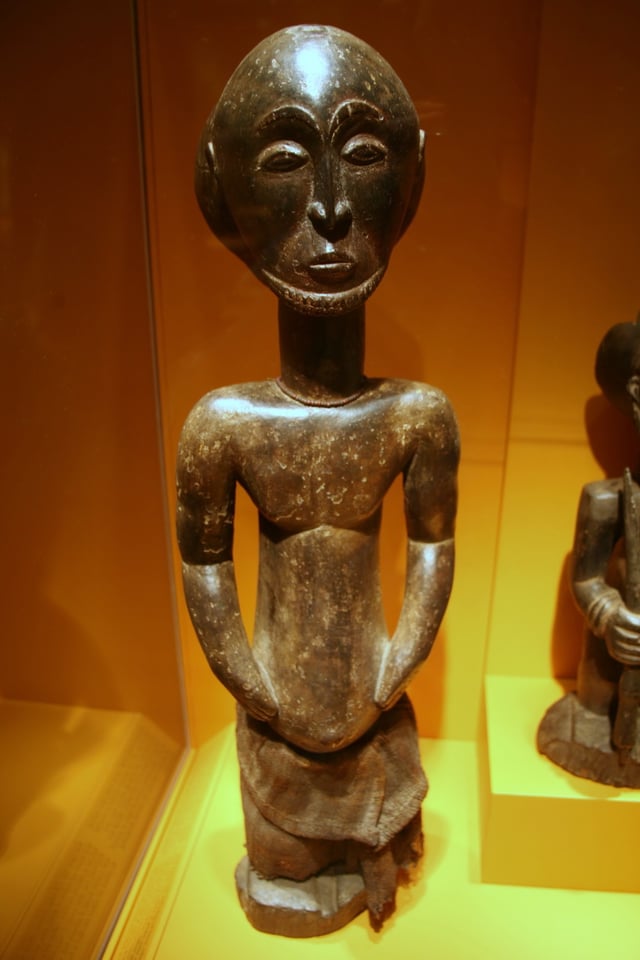
A Hemba male statue
The culture of the Democratic Republic of the Congo reflects the diversity of its hundreds of ethnic groups and their differing ways of life throughout the country — from the mouth of the River Congo on the coast, upriver through the rainforest and savanna in its centre, to the more densely populated mountains in the far east. Since the late 19th century, traditional ways of life have undergone changes brought about by colonialism, the struggle for independence, the stagnation of the Mobutu era, and most recently, the First and Second Congo Wars. Despite these pressures, the customs and cultures of the Congo have retained much of their individuality. The country's 81 million inhabitants (2016) are mainly rural. The 30% who live in urban areas have been the most open to Western influences.
Music
Another feature in Congo culture is its music. The DRC has blended its ethnic musical sources with Cuban rumba, and merengue to give birth to soukous.[207] Other African nations produce music genres derived from Congolese soukous. Some of the African bands sing in Lingala, one of the main languages in the DRC. The same Congolese soukous, under the guidance of "le sapeur", Papa Wemba, have set the tone for a generation of young men always dressed up in expensive designer clothes. They came to be known as the fourth generation of Congolese music and mostly come from the former well-known band Wenge Musica.
Sports
Many sports are played in the Democratic Republic of the Congo, including football, basketball, and rugby. The sports are played in numerous stadiums throughout the country, including the Stade Frederic Kibassa Maliba.[208] As Zaire they have participated in the World Cup Football (Final stage) in 1974.
Internationally, the country is especially famous for its professional basketball NBA and football players. Dikembe Mutombo is one of the best African basketball players to ever play the game. Mutombo is well known for humanitarian projects in his home country. Bismack Biyombo, Christian Eyenga, and Emmanuel Mudiay are others who gained significant international attention in basketball. Several Congolese players and players of Congolese descent—including strikers Romelu Lukaku, Yannick Bolasie, and Dieumerci Mbokani—have gained prominence in world football. DR Congo has twice won the African Cup of Nations football tournament.
Food
Media
Newspapers of the DRC include L'Avenir, Radion Télévision Mwangaza, La Conscience, L'Observateur, Le Phare, Le Potentiel, Le Soft and LeCongolais.CD,[209] a web-based daily.[210] Radio Télévision Nationale Congolaise (RTNC) is the national broadcaster of the Democratic Republic of the Congo. RTNC currently broadcasts in Lingala, French, and English.
Literature
Congolese authors use literature as a way to develop a sense of national consciousness amongst the Congo people. The tragic history of colonialism and war lead the Congolese people to settle in a place of complacency, accepting the culture that was forced upon them by Belgium.
The Belgian attitude was paternalism, training and treating Africans as if they were children. Belgian parliament replaced the privately owned free state. This acceptance led to a diffusion of language, and many Congolese people spoke, and wrote in French.
Modern Congolese literature began to emerge in the late 1950s. There are a few rare pieces of literature dated back to before WWI, but it was not until about 1954 that literature written in French made its appearance in the Congo. After gaining their independence from Belgium in the 1960s, new authors, such as Guy Menga and Jean Pierre Makouta-Mboukou, were inspired by older authors, such as Jean Malonga, and used writing to bring attention to new issues affecting the Congo. The rise of female authors began in the 1970s introducing diversity to Congolese literature and support for gender empowerment. Many authors who have contributed to the success of Congolese literature are now living abroad due to economic and political issues.[211]
Frederick Kambemba Yamusangie writes literature for the between generations of those who grew up in the Congo, during the time when they were colonised, fighting for independence and after. Yamusangie in an interview[212] said he felt the distance in literature and wanted to remedy that he wrote the novel, Full Circle, which is a story of a boy named Emanuel who in the beginning of the book feels a difference in culture among the different groups in the Congo and elsewhere.[213]
Rais Neza Boneza, an author from the Katanga province of the Democratic Republic of Congo, wrote novels and poems to promote artistic expressions as a way to address and deal with conflicts.[214]
Born in 1907, Jean Molonga, was a novelist and storyteller, who sat in parliament from 1946 to 1951. He was noted for his original work, Coeur d'Aryenne, Heart of Aryenne, consisting of controversial themes; cultural identity, national unity, and reformation of the oppressed.[215]
These authors, along with others, used their platforms to bring awareness to the crises and conflicts that took place in the Congo.
Environmental issues
A dense tropical rainforest in the DRC's central river basin and eastern highlands is bordered on the east by the Albertine Rift (the western branch of Africa's Great Rift System). It includes several of Africa's Great Lakes.
Major environmental issues
DR Congo's major environmental issues include:
poaching, which threatens wildlife populations
water pollution
mining
Displaced refugees cause or are otherwise responsible for significant deforestation, soil erosion and wildlife poaching. Another significant issue is environmental damage from the mining of minerals, especially diamonds, gold, and coltan – a mineral used to manufacture capacitors.
Species and Biodiversity loss
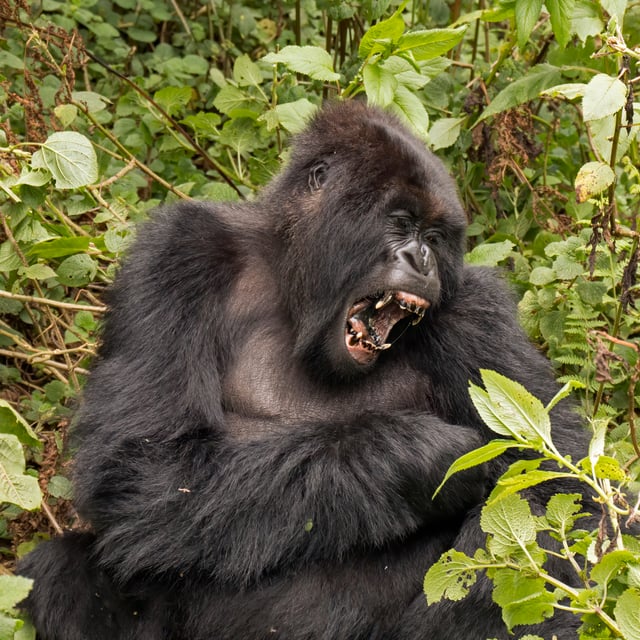
The endangered Mountain Gorilla, half of its population live in the DRC's Virunga National Park, making the park a critical habitat for these animals.[216]
The environmental problems associated with The Democratic Republic of Congo (DRC) affect its many endemic species of flora and fauna. The DRC has the worlds second largest contiguous rain forest after the Amazon as well as other ecosystems including Savanna, swamps and flood plains. According to the World Wildlife Fund, these unique habitats and species make the DRC one of the most valuable yet vulnerable areas in the world for biodiversity, wildlife protection and rainforest sustainability.[217]
Species loss has been cited as a problem in the DRC, brought about or exacerbated by reasons that include deforestation for mining, wood fuel, infrastructure or agriculture, war, illegal poaching and increased consumption of bush meat due to overpopulation and lack of food security.[218] Some attempts to combat species loss in countries such as the DRC are actions such as the UN's Sustainable Development Goals (SDG), specifically SDG 15 Life on Land, the primary goals of which is to increase reforestation and biodiversity and reduce species loss, desertification, and illegal poaching.[219] One of the primary defences for species and habitat protection in the DRC is its system of national parks and reserves, which gives protected status to nearly 12% of the DRC's rainforest.[220] Five of these parks and reserves are UNESCO world heritage sites, including Africa’s first national park Virunga national park. All of these parks have been put on the World Heritage in Danger List.[221] Poor governance and low economic conditions have reduced the effectiveness of these protections, especially during war times.[220] The human cost of protecting these parks has also been high with 200 park ranger deaths in the past 20 years.[222] Virunga national park and Salongo National Park, both of which are UNESCO world heritage sites are currently being looked at for mining and oil exploration. The move would open 21.5% of the Virunga park for exploitation, this is highly criticised by animal rights activists as it would threaten the habitat of Mountain Gorillas and other endangered species.
Deforestation
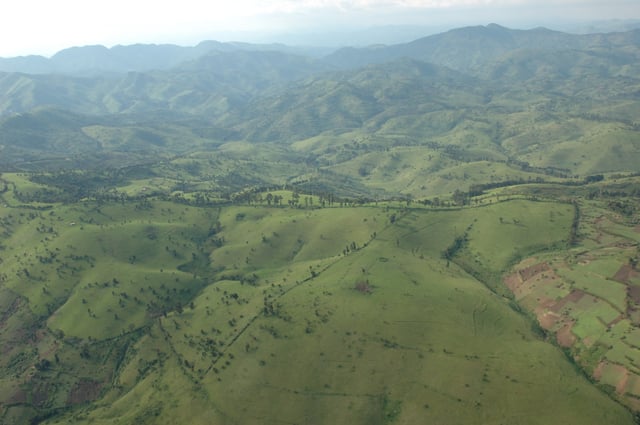
Deforested lands in the DRC, which used to be forest
Between 2000 and 2014 the DRC lost an average of 570,000 hectares (0.2%) of rainforest to deforestation per year, with the highest amount of deforestation coming between 2011 and 2014.[223] Deforestation is the primary cause of biodiversity reduction and species loss globally, through habitat loss and fragmentation.[224] One of the goals of the SDG 15 is to reduce deforestation and encourage reforestation by 2020
The DRC has Africa’s largest rainforest, which is under the threat of deforestation through mining operations, agriculture, infrastructure and wood fuel. In the DRC 94% of wood taken from the rainforest is used for wood fuel, mainly due to poverty, lack of energy infrastructure and the decentralised nature of its population. To mitigate this aid agencies have tried to promote agro-forestry with fast growing trees to avoid over exploitation of the rainforests.[225] Other large drivers of deforestation include mining and conflict, during the Congo conflict deforestation by militia groups was high for wood fuel, small mining operations and illegal logging to fund their operations. However, conversely conflict reduced deforestation for large scale mining due to security instability.[220]
One policy being attempted to reduce the deforestation and increase biodiversity in the DRC is the UN-REDD program, which uses emissions trading system so that developed nations can offset their carbon emissions by paying developing nations with rainforest to manage and conserve their forest.[226]
Bush meat
Bush meat refers to any meat which is procured from the wild, as overpopulation and continual conflicts in the DRC has led to food shortages this has therefore increased the use of bush meat. Although, data on bush meat use is not extensive, studies estimate 6 million tonnes of animals are taken for bush meat globally each year.[227] What animals are hunted are done so indiscriminately without thought of the importance of certain species that could be eco-system engineers or keystone species.[227]
Bush meat is an important source of protein for millions in the DRC, especially in rural areas where it makes up 50-70% of meals and for some who cannot afford farmed produce it is a free meal.[228] A recent study in the DRC revealed that almost all of the animals are taken from the Congo each year, at 93% of all live animals there are in the forest are extracted for bush meat, whereas a sustainable rate would be 20%.[229] This is a huge amount compared to the Amazon where bush meat is hunted at only 3% the rate of the Congo.[229] the study reveals the only way to solve this is to find other food sources to feed people in the Congo Basin as bush meat is their only means of eating.[229] Another study showed that the species of bush meat in the meat markets of the DRC's third largest city Kisangani were primarily Artiodactyla at 40.06% of the carcasses sold then primates at 37.79% of carcasses sold.[230]
Recently the prevalence of hunting for bush meat has declined because of the risk to hunters and butchers from the Ebola virus from specifically ape and bat meat.[231] Even though when the meat is cooked smoked or dried it kills the virus, business has dropped significantly with some hunters reporting as much of a reduction in sales of 80%.[231]
Conflicts
There has been a war in the DRC in different levels of intensity since 1994 when the country was called Zaire.[232] Although what was known as Africa's World War had ended in 2003 the eastern part of the country still has ongoing skirmishes between rebel groups and government forces.[232] No other method has reduced species population so dramatically than conflict, when a militia reached the Garamba National Park in 1997, within three months half of the park's elephants, two thirds of the buffalo, and three quarters of its hippos vanished.[233] The reason conflict is so damaging to wildlife is the increased use of bush meat to feed soldiers, the prevalence of weapons, the lucrative industry of selling exotic animals and ivory as well as the general failure of law and order.[233] According to another study which was taken during the time of the civil war in the Okapi Faunal Reserve, there was a 50% reduction in the abundance of elephants and a vast change in the distribution of them to the more secluded areas of the park.[234]
See also
Outline of the Democratic Republic of the Congo
Index of Democratic Republic of the Congo-related articles


